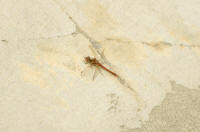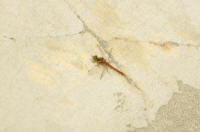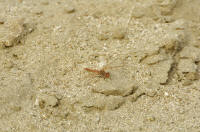|
|
|
Taxonomic Hierarchy |
|
Kingdom: |
Animalia -- animal |
|
Phylum: |
Arthropoda -- arthropods |
|
Class: |
Insecta -- insects |
|
Order: |
Odonata -- Dragonflies and Damselflies |
|
Suborder: |
Anisoptera -- Dragonflies |
|
Family: |
Libellulidae -- Skimmers |
|
Genus: |
Sympetrum |
|
Species: |
Sympetrum corruptum |
|
|
Description: |
|
Diet: |
|
Naiad- This is
a small naiad with a maximum length of 3/4 inch (19 mm). It
is mottled green and brown in color, and the abdomen is
marked along the top with a pair of stripes. While the
naiads of many dragonfly species are equipped with hooks
and/or spines on the abdominal segments, the naiads of this
species may have only one tiny, rear-facing spine on each
side of abdominal segment eight or else no hooks or spines
at all. |
|
Naiad- Naiads
feed on a wide variety of aquatic insects, such as mosquito
larvae, other aquatic fly larvae, mayfly larvae, and
freshwater shrimp. They will also eat very small fish and
tadpoles. |
|
Adult-
This is a small to
medium-sized dragonfly (but large for this genus) with a
length of 1 5/8 to 1 11/16 inches (39 to 42 mm). The abdomen
is quite slender. Mature males have a base color of dark
brownish black. Each side of the thorax may be marked with a
pair of yellow spots. The abdomen is marked with an
eye-catching pattern of red, pink, and golden brown. The
leading edges of the wings have pinkish wing veins. Mature
females are marked similarly but with less red. Immature
males and females are much paler in color and are mottled
with pale green, pale yellow, golden brown, and orange. The
leading edges of the wings have brownish or "regular"
(non-colored) veins. |
Adult- The
dragonfly will eat almost any soft-bodied flying insect
including mosquitoes, flies, small moths, mayflies, and
flying ants or termites. |
|
Size: |
|
|
Medium, length 34 - 43 mm, wingspan 60 - 66 mm |
|
Range Information: |
|
Habitat: |
|
This
species is found from British Columbia east to Ontario,
extending south through much of the U.S. to southern
California east to Florida. It migrates as far south as
Honduras in Central America, and also occurs in eastern
Asia. It occurs throughout Idaho except at the highest
elevations.. |
|
This
dragonfly can be found near ponds and lakes. |
|
U. S.
Flight
Season: |
|
California Flight Period: |
|
Early
May to mid-September |
|
Year round, migratory; may over winter |
|
Ecology: |
|
Reproduction: |
|
The
naiads are found in debris on the bottom of lakes or ponds.
They do not actively pursue prey but wait for it to pass by,
a strategy which affords them protection from other
predators. Naiads emerge as adults at night. Adults
generally fly from early May to mid-September. Hunting
occurs from perches on rocks or bare branches. The Latin
name for this genus, Sympetrum, means "with rock" and refers
to their habit of basking on rocks to absorb heat early in
the day. This species is often seen in migratory swarms
traveling south in the fall, along with the Common Green
Darner (Anax junius) and the Black Saddlebags (Tramea
lacerata). Those traveling south in the fall are usually
immature, while those that appear in Idaho in the spring are
usually mature. It was previously believed that the mature
Variegated Meadowhawks appearing in the northern states in
the spring had over-wintered there, but it is now believed
that they emerged further south and migrated north. It is
not known if there are resident, non-migratory populations
in Idaho. This species is not seen in October in Idaho, as
are many other members of this genus. Those observed in
August and September are almost always immature, which
suggests that they leave the area soon after emerging.
|
|
The
female flies with the male still attached after mating (a
position called "in tandem") and lays her eggs in lakes and
ponds by dipping the tip her abdomen on the surface of the
water. |
|
Conservation: |
|
Sources : |
|
G1
G2
G3
G4
G5 |
|



|
|
G5 -
Populations are widespread, abundant, and secure.
|
|







